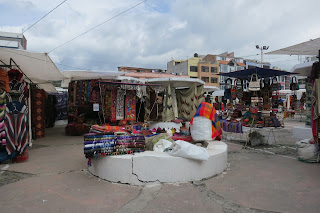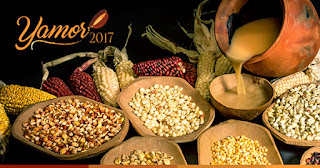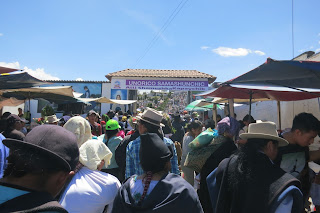La Plaza de Ponchos
I've talked about the Plaza de Ponchos in a lot of my posts because I spend a great deal of time there. It's an incredible market, so I wanted to dedicate an entire post to its history and what to expect if you visit the Plaza. (Ok, so it's one of my favorite places on Earth, and maybe I just wanted an excuse to write about it, but just go with it.)
The
view from above of Plaza de Ponchos in Otavalo shows how large and crowded the market is.
Source:
www.otavalomarket-ecuador.com
There are vendors in the Plaza de Ponchos every day of the week, but the biggest days (with the most people) are Wednesday and Saturday. The Saturday Otavalan market in the Plaza de Ponchos is famous worldwide. Tourists visiting Ecuador generally make a point to visit this market; tour guides nearly always bring their groups to the Plaza de Ponchos. It's not uncommon to hear loudspeaker announcements telling tour groups to return to such and such a bus by a certain time.
Because of its size and popularity, it is the perfect market for handicrafts that are easily carried home by tourists. You can find just about everything: textiles, bags, backpacks, jewelry, sculptures, art, woodworking (from San Antonio), knickknacks, including dream catchers and gourds decorated using the same technique as woodburning (pyrography from Peru). In fact, dream catchers have become incredibly popular among indigenous peoples in Ecuador in a sort of Pan-American indigenous movement. Also, as one man admitted, they can make and sell them here much cheaper than in the US, so a lot of people like buying them here. The same goes for Navajo textiles, as many Navajo designs can be found in Otavalan textiles. Pan-American indigenous solidarity or just good business? You decide. They certainly aren't amateurs, as tourism is one of the largest sources of Ecuadorian national income.
Although many vendors will tell you everything in the market is locally made, there are actually items for sale from all over Ecuador, Peru, China, and sometimes other countries. It's not uncommon to Otavalans to travel abroad, bring something back with them, and then start making it locally to sell here in the market. And once one family starts producing that item, you can bet others will. For example, these textiles replicate a style from Guatemala. Some tourists may be put off by finding the same items in different markets in Latin America, while that actually fits the narrative of continuity/homogeneity that other tourists expect to find throughout Latin America. Thus, their strategy of importing goods or replicating items originating elsewhere generally pays off.
The competition for market space is intense, and most plots have been passed through the same family for multiple generations. In addition, it is quite expensive to rent space within the market. Vendors have to pay daily dues (which are higher on Saturdays) in addition to annual fees to use the space. The concrete kiosks are divided into quarters, and it is increasingly difficult for a family to rent more than 2 quarters. As such, one has to be strategic about what they bring and display. They typically transport their goods in large "bags" (see below) made of large pieces of fabric tied around the handicrafts and often stash a larger selection under a table, so they can grab specific pieces if desired.










Comments
Post a Comment